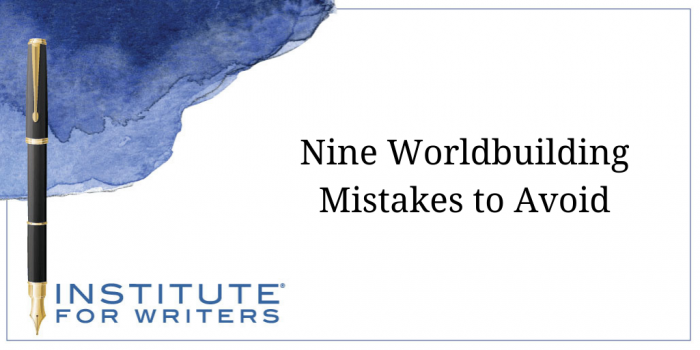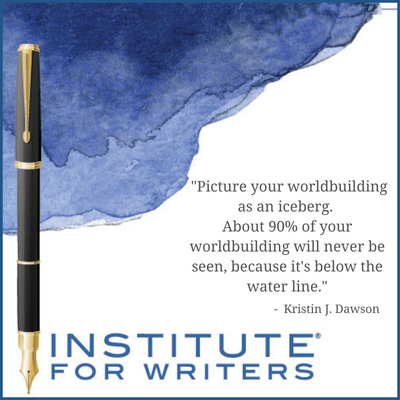1000 N. West Street #1200, Wilmington, DE 19801
© 2024 Direct Learning Systems, Inc. All rights reserved.

We teach our students how to write and get published!
View our Course Catalog >
In this article, you’ll learn about not just nine common errors in worldbuilding, but also suggestions on how to fix them.
This article is the third in a series of four worldbuilding articles, so for more on this topic, be sure to check these all out:
Article #1: Worldbuilding Checklist
Article #2: Digging Deeper into your Worldbuilding
Article #3: 9 Worldbuilding Mistakes to Avoid (this article)
Article #4: Worldbuilding Bible
To keep the pace clipping along and the word count under control, authors generally select core worldbuilding elements (see article #1) and go into glorious detail. In the previous article, I relayed how Suzanne Collins emphasized certain worldbuilding elements, but otherwise, she kept other elements “under the water.”
 What do I mean by “under the water?” Picturing your worldbuilding as an iceberg. About 90% of your worldbuilding will never be seen, because it’s below the water line. So why expand your world to include things the reader will never see? Because it will keep your story world consistent and add nuances and depth between the lines.
What do I mean by “under the water?” Picturing your worldbuilding as an iceberg. About 90% of your worldbuilding will never be seen, because it’s below the water line. So why expand your world to include things the reader will never see? Because it will keep your story world consistent and add nuances and depth between the lines.
You can apply most speculative fiction books to this test. For instance, the Kingfountain series, by Jeff Wheeler, is a classic political intrigue, so of course there is a lot of governmental elements (kings, dukes, and power). The ethics/values, religion, history, and artifacts are all beautifully detailed. But food and architecture are painted with broad strokes.
While we don’t want the whole iceberg on the page, the elements the author focuses on should have natural places in the story to flesh out your worldbuilding. These “fleshed out” touches help your story come alive in the reader’s minds. In the Kingfountain series mentioned above, Wheeler is known for his amazing characters, people love re-visiting his worlds because they feel so rich. We get to experience the inside of the abbeys in great detail, from the chess-patterned tile, to the fountains, to the people on the steps, and the coins in the water.
Because the abbeys are an important element of the religious and magical aspects of the story, it makes sense that the religious locations would be detailed.
We get it. You know your world. But don’t info-dump or go into great exposition. Let us naturally learn about the world as the characters engage with it. (See the example of The Hunger Games in my previous article.) Of course, readers don’t want to be confused. This is something all authors must learn to balance, but you can do it!
All magic has a cost! If magic can be done indefinitely, with no exhaustion or danger of any kind, that’s boring. Boundaries create confines that are more exciting to work inside of and more exciting to read. Examples I love:
• In The Dresden Files, by Jim Butcher, set in a contemporary city, magic doesn’t mix well with technology (even landline phones). The magic makes using any sort of technology go haywire.
• In Before the Broken Star, by Emily R. King, the main character has a clockwork heart. She doesn’t know how long the mechanism will last and stress causes her heart to malfunction. So she must stay calm and cool under pressure at all times.
 In today’s world, you’re competing less with other books and more with video games, Netflix, and social media. In the past, writers had a couple of chapters to capture their readers. Now we have seven sentences. Seven. And if the reader likes those early sentences, they’ll read the first page. Then if you hook them again, they’ll read the next page, and the next. You get the idea!
In today’s world, you’re competing less with other books and more with video games, Netflix, and social media. In the past, writers had a couple of chapters to capture their readers. Now we have seven sentences. Seven. And if the reader likes those early sentences, they’ll read the first page. Then if you hook them again, they’ll read the next page, and the next. You get the idea!
A huge mistake writers make is diving deep into their world, the descriptions, and magic in the first chapter. This often bogs down the pacing without reeling in the reader. USA Today bestselling author, Raye Wagner, has written four different fantasy series (all set in different worlds). Wagner shares this:
“My best advice on world building was from my co-author USA Today bestselling author Kelly St. Clare: Chapter one isn’t the place for world building, it should be centered on The Hook.
This where you want to introduce your character and their conflict. No backstory. Minimal—if any—world building unless it’s to establish or augment the main character’s desire/problem/need. Make this chapter all about intrigue, suspense, tension, and establish a strong connection between your character and the reader. Even better, make the character’s need something the reader wants, too: true love, a crazy adventure, wealth, fame, or slaying a dragon.
Keep it simple. Zero confusion. No strange, unfamiliar, or huge words, nor sweeping descriptions. Capture the reader and then catapult them into chapter two.”
Raye goes on to suggest that detailed worldbuilding is best held until chapter three. By this point, the readers are vested and looking (desperately) for answers that backstory and worldbuilding will provide, if we’ve done our jobs right.
This advice is gold, people!
This is more common with new writers who have primarily read books written in the 1980s and 1990s. Most writers do not want to write monolithic cultures, and especially not harmful stereotypes. To avoid this, be sure to check out the podcast “Writing Excuses” for several tips and tools that all writers need to have in their back pocket.
Worldbuilding informs the story. Sometimes greatly. But characters with depth, arcs, pacing, and plot are all critical to the story as well. Don’t spend ten years creating a world and forget to create a story that goes inside!
When you’re creating your world, you will have tons of ideas and notes. Essentially, when writers are talking about a book bible, it’s a place where you put the guts of your book all into one easy-to-reference location. Remember tip #1 above? While you’ll only show 10% of your world, you’ll want to write down as much of your world as you can so you can refer to it. (More on this in the next article, “Worldbuilding Bible“.)
Readers don’t want every detail in your book bible to be printed on the page. Do they like lists of magic? Brandon Sanderson’s fans do. Do they want a character list? Yes, especially if there are more than a dozen characters. But your readers don’t want the story to read like a giant bibliography, thankyouverymuch. (Refer back to tip #1!)
For the final article, we’ll explain what book bibles can do for you. Not only does this topic relate to the tips shared above, but it’s one of the topics that came up when I discussed worldbuilding with my author community. I came to realize that book bibles warranted their own article. So check out the final article on worldbuilding!
Let our one-on-one mentors help you avoid these and other mistakes in your writing. Take the assessment here!
Article #1: Worldbuilding Checklist
Article #2: Digging Deeper into your Worldbuilding
Article #3: 9 Worldbuilding Mistakes to Avoid
Article #4: Worldbuilding Bible
Kristin J. Dawson is a non-recovering chocolate and romantic English movie addict who loves to read science fiction and fantasy. You can find her most often indulging her favorite things at 2 am — night owls unite! Kristin writes high fantasy with political intrigue, a bit of romance, and of course, magic. She’s was a 2019 UTOPiAcon Debut Book Award Nominee and Swooney Award Nominee. When she’s not writing, taking her kids on mountain adventures, or cleaning out the chicken coop, she’s probably trying to talk her author friends into more shenanigans.
Chat with Kristin on Instagram (@KristinImagines), on Facebook (@KristinJLiterary), or her website at kristinjdawson.com.
1000 N. West Street #1200, Wilmington, DE 19801
© 2024 Direct Learning Systems, Inc. All rights reserved.
1000 N. West Street #1200, Wilmington, DE 19801
© 2024 Direct Learning Systems, Inc. All rights reserved.
1000 N. West Street #1200, Wilmington, DE 19801
© 2024 Direct Learning Systems, Inc. All rights reserved.
4 Comments